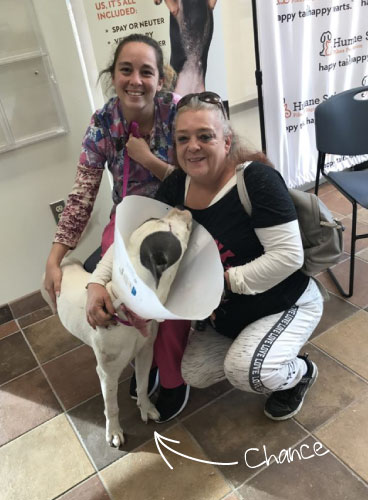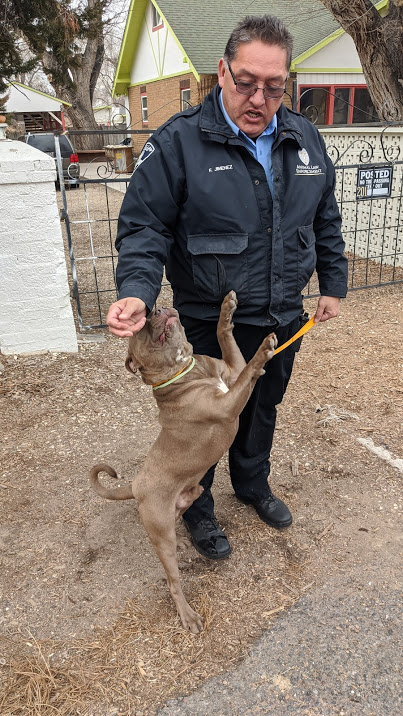Animal Law Enforcement: More than just "Dog Catchers"
They’re not just “dog-catchers,” they are Animal Law Enforcement (ALE) officers, and their job is to protect people from pets and pets from people. In fact, in 2019 alone, ALE responded to 36,293 calls for service, of which 2,300 were for dog bites and 4,091 resulted in investigations for animal cruelty.
So what exactly does an ALE officer do? To find out, we took a ride with an officer, and here’s what we learned!
Animal Control:
First and foremost, ALE officers provide animal control, meaning they help with animal issues called in by the community. There are four types of calls, which are responded to in order of priority:

Priority 1 = Injured animals, animals in distress, aggressive animals, assisting other law enforcement agencies. An example of this type of call is the story of Chance. In March of 2020, ALE responded to a call from the Pueblo Police saying there were shots fired and an animal in distress. ALE quickly jumped in their trucks and made their way to the scene, where they found sweet Chance, a pit-bull type dog, hiding in the bushes. After coaxing him out, they saw he had been shot in the leg. Because he was an animal in distress, ALE rushed him to our veterinary team, who amputated his leg. Chance was also added to the “Found Pet” section of our website, where his owners spotted him and came in to bring him home! Unfortunately, because there were no witnesses to the shot, we couldn’t identify the person responsible for hurting Chance.
Priority 2 = Picking up confined strays, non-urgent investigations, obtaining signed complaints. When we were riding with ALE officers, we quickly learned that they get A LOT of priority 2 calls, especially for confined strays. That means, when people see a stray animal, they are keeping said animal contained and calling ALE to come and get it. We so appreciate these good Samaritans for ensuring these stray pets are kept safe while waiting to be reunited with their owners! An example of this is Sam. During our ride-along with ALE, we got a call about a stray dog. When we arrived, Sam was there, cheerily waiting for us! We scanned him for a microchip, and because his collar had no tags, we brought him to HSPPR to see if an owner would come forward to claim him. When nobody did, he was put up for adoption! (Pssst. Lost your pet or found a pet? Fill out a report here to help reunite animals and owners!)
Priority 3 = Issuing warnings, investigation follow-ups, serving summonses. An example of this type of call is the story of a dog fighting ring in Pueblo. In February of 2018, Animal Law Enforcement (ALE) officers and the Pueblo Police Department arrested Jerry Grady and his partner, Armando Vigil, when they served them with a search warrant and found 19 dogs on the property, which were brought to HSPPR for medical care. Evidence showed many of the dogs were used for dog fighting, were left chained up without access to water and were severely injured and scarred due to abuse and recent dog fights. At the time the warrant was issued, this was a priority 1 case. However, when ALE officers continued to follow up on the case, issue court summons and gather additional evidence, these types of actions were considered priority 3, as the dogs were already safely in our shelter. The good news is that both parties were successfully charged for animal cruelty—all thanks to ALE!
Priority 4 = Patrols, nuisance calls, property inspections, and in Pueblo picking up deceased animals. Pueblo ALE is contracted by the city and county of Pueblo to pick up dead animals from public streets, but in Colorado Springs, the city and county road departments do this job. These types of calls are to make sure any stray animal that was reported is checked up on and to follow up on previous calls about things like providing proper shelter for animals and noisy pet complaints. “Patrols,” or looking for a reported stray animal, are one of the most common types of calls to which ALE responds. This is why licensing, tagging, and microchipping your pet is so important! This is truly the trifecta for easy identification of an animal. Because tags wear and fall off and microchips can move, it’s important to license your pet, and illegal to not in most areas. Licensing, microchipping, and tagging your pet can ensure that it never has to enter a shelter. Instead, when ALE finds a loose pet, and it has one of these three things that enables them to locate an owner, the first thing they do is reach out to said owner and return the pet! This happened 601 times in 2019, meaning 601 pets were reunited with their owners without ever having to set foot in a shelter.
Community Resource:
After talking with our seasoned ALE officer, Officer Jiminez, with whom we rode for the day for research for this post, we realized that apart from providing animal control, ALE is a community resource in many other ways, too! “It boils down to respect, and you have to respect the community members you serve…there is no ‘I,’ only ‘we,’ when it comes to helping our community,” he said. “We really are Better Together.”
They’re there when you need them:
ALE officers work round-the-clock and take shifts being on-call. As a community resource, they are heavily leaned on by the local police departments in the communities they serve. This means if an animal is going to be left behind due to an arrest, or if police respond to a call and see an animal in need, ALE is called into assist. As an example, in February 2020, Pueblo Police called ALE to the scene of a domestic violence case. When Officer Jiminez arrived, he found three animals in very poor condition, as a result of being nearly starved to death. He immediately brought them to our shelter, where we put them on round-the –clock treatment to help them recover. Unfortunately, the two cats passed away, but the dog that was in the home is gaining weight and on the road to recovery!
They don’t hate, they educate:
ALE officers often find themselves responding to calls for animals that are clearly loved and well cared for, but the owners are missing key information about keeping their pets safe. For example, many pet owners don’t leash their dogs in their un-fenced yard. In many instances, ALE could file charges for failure to comply to leash laws, but they also understand that some people just don’t know the laws. In these instances, Officer Jiminez and his fellow ALE team will opt to talk through the situation with the owners and explain that unleashed dogs could get hurt by running into traffic and pose a risk for other people and pets walking by the property. Nine times out of 10, owners thank them for this information and resolve the issue! “You have to have compassion and understanding in order to make a difference,” said Jiminez,

As you can see, there is SO MUCH MORE to Animal Law Enforcement than just catching dogs. The team is a necessary resource for keeping people and pets together and safe!
#HappyTailsHappyHearts







